
Three Anglo-Saxon metrical charms "Against a dwarf" (Old English :Ƿið dƿeorh) are contained within the Lacnunga, which seek to heal an afflicted person by ridding them of a dwarf.

Three Anglo-Saxon metrical charms "Against a dwarf" (Old English :Ƿið dƿeorh) are contained within the Lacnunga, which seek to heal an afflicted person by ridding them of a dwarf.
The remedies LXXXVIIc and LXXXVIIIc consist of writing Christian symbols, such as crosses and both Latin and Greek letters, along the arms of the sick person. This is then followed by mixing grated celandine [lower-alpha 1] with ale and invoking the names of saints, including the Welsh Saint Macutus. [1]

Remedy XCIIIb is the most detailed of the Ƿið Dƿeorh charms, consisting of writing the names of the Seven Sleepers of Ephesus on Communion wafers before reciting a galdor :
Wið dweorh: man sceal niman .VII. lytle oflætan swylce man mid ofrað ⁊ wri[t]an þas naman on ælcre oflætan: maximianus malchus. iohannes. Martinianus. dionisius. con-stantinus. serafion. þænne eft þæt galdor þæt [man] her æfter cweð[eð] man sceal singan, ærest on þæt wynstre eare, þænne on þæt swiðre eare, þænne [b]ufan þæs mannes moldan; ⁊ ga þænne an mædenman to ⁊ ho hit on his sweoran, ⁊do man swa þry dagas. him bið sona sel. | Against dwarf: one must take seven small wafers such as are used for Communion, and write these names on each wafer: Maximianus, Malchus, Johannes, Martinianus, Diony-sius, Constantinus, Seraphion. Then, next, the spell that is quoted hereafter is to be sung, first in the left ear then in the right ear, then above the man’s head; and then let a virgin approach and hang it on his neck, and let this been done in this way for three days. It will go better with him directly. |
| —Old English text [2] | —Hines Translation [2] |
It has been noted that several components of this charm suggest that it was old at the time of its recording, such as the use of the word "inspiden", which would have had no clear meaning at the time of writing, and a lack of an alliterating vowel where expected in line 5 of the galdor. [3]
It has been argued that the Ƿið Dƿeorh charms form part of a wider North Sea Germanic tradition that links dwarfs to the onset of sickness, also attested in the 8th century CE Ribe skull fragment and a lead plaque found near Fakenham in Norfolk dating to the 8th-11th century CE. [4] [5] In this cultural context, it has been argued that attempting to discriminate between the dwarf and the disease it is causing is not necessarily helpful, given that the banishing or killing of the harmful dwarf also is believed to lead to recovery from the sickness. [6]
It has been proposed that the sickness in question is related to sleeping because of the inclusion of the Seven Sleepers in the charm. According to one source, "The names of the Seven Sleepers of Ephesus occur in various charms of the Middle Ages. They are usually, as might be expected, to secure sleep, but in some cases are to be employed against fever". [7]
The conception of the dwarf in remedy XCIIIb has been proposed to link to the concept of a mare, a harmful being in Germanic folklore that is the root of the word "nightmare" and has been equated with the phenomenon of sleep paralysis. According to this theory, the dwarf in this charm is a manifestation of a night monster, as dwarfs were linked to the idea of harmful spirits and thought to be capable of causing physical harm. [8] Similarity between the dwarf in XCIIIb and mares in medieval and later Germanic folklore is further seen in the conception of both beings riding their victims, causing symptoms such as injury, hallucinations and fevers. [9]
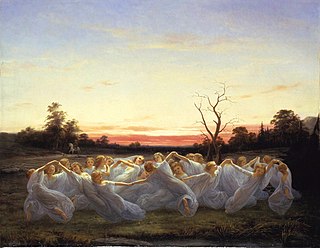
An elf is a type of humanoid supernatural being in Germanic folklore. Elves appear especially in North Germanic mythology, being mentioned in the Icelandic Poetic Edda and Snorri Sturluson's Prose Edda.

A dwarf is a type of supernatural being in Germanic folklore. Accounts of dwarfs vary significantly throughout history; however, they are commonly, but not exclusively, presented as living in mountains or stones and being skilled craftspeople. In early literary sources, only males are explicitly referred to as dwarfs. However, they are described as having sisters and daughters, while male and female dwarfs feature in later saga literature and folklore. Dwarfs are sometimes described as short; however, scholars have noted that this is neither explicit nor relevant to their roles in the earliest sources.

In both Christian and Islamic tradition, the Seven Sleepers, otherwise known as Aṣḥāb al-kahf, Sleepers of Ephesus and Companions of the Cave, are said to be a group of youths who hid inside a cave outside the city of Ephesus around AD 250 to escape persecution and emerged many years later. In the Christian version they are seeking to escape one of the Roman persecutions of Christians and awake some 300 years later. Another version of the story appears in the Quran (18:9–26). It was also translated into Persian, Kyrgyz, and Tatar.

A wight is a being or thing. This general meaning is shared by cognate terms in Germanic languages, however the usage of the term varies greatly over time and between regions. In Old English, it could refer to anything in existence, with more specific usages arising in Middle English, perhaps due to the term of similar meaning in Anglo-Norman, creature. In Modern Fantasy, the term is widely used, often meaning specifically a being which is undead.

A mare is a malicious entity in Germanic and Slavic folklore that walks on people's chests while they sleep, bringing on nightmares.
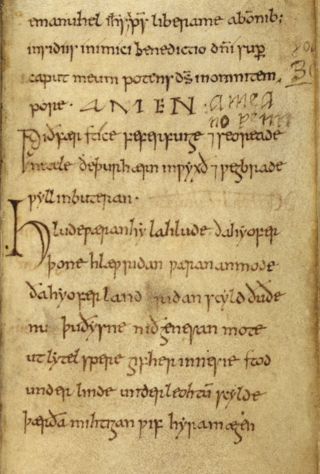
"Wið fǣrstice" is an Old English medical text surviving in the collection known now as Lacnunga in the British Library. Wið fǣrstiċe means 'against a sudden/violent stabbing pain'; and according to Felix Grendon, whose collection of Anglo-Saxon charms appeared in the Journal of American Folklore in 1908, “the charm is intended to cure a sudden twinge or stitch, possibly rheumatism that can be due to being shot by witches, elves, and other spirits that fly through the air.” Scholars have often sought to identify this as rheumatism, but other possibilities should not be excluded. The remedy describes how to make a salve, but its main interest lies in the unique charm which follows. This describes how the færstice has been caused by the projectiles of 'mighty women', whom the healer will combat. The charm also mentions elves, believed responsible for elfshot, and provides the only attestation outside personal names of the Old English form of the name of the old Germanic gods, known as the Æsir in Norse mythology.

Dragons, or worms, are present in Germanic mythology and wider folklore, where they are often portrayed as large venomous serpents. Especially in later tales, however, they share many common features with other dragons in European mythology.
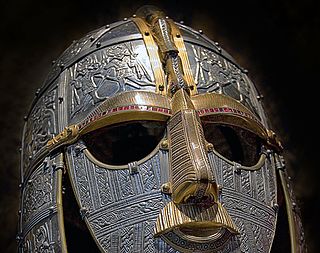
Anglo-Saxon paganism, sometimes termed Anglo-Saxon heathenism, Anglo-Saxon pre-Christian religion, or Anglo-Saxon traditional religion, refers to the religious beliefs and practices followed by the Anglo-Saxons between the 5th and 8th centuries AD, during the initial period of Early Medieval England. A variant of Germanic paganism found across much of north-western Europe, it encompassed a heterogeneous variety of beliefs and cultic practices, with much regional variation.
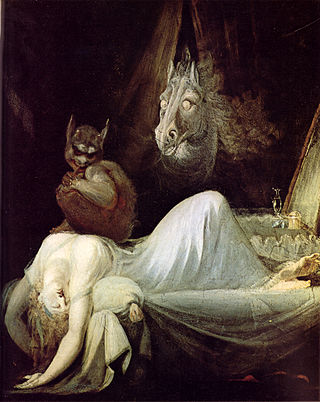
An Alp is a supernatural being in German folklore.
The Nine Herbs Charm, Nigon Wyrta Galdor, Lay of the Nine Healing Herbs, or Nine Wort Spell is an Old English charm recorded in the tenth-century CE. Anglo-Saxon medical compilation known as Lacnunga, which survives on the manuscript, Harley MS 585, in the British Library, in London. The charm involves the preparation of nine plants.
The Æcerbot is an Anglo-Saxon metrical charm recorded in the 11th century, intended to remedy fields that yielded poorly.

In Germanic mythology, an idis is a divine female being. Idis is cognate to Old High German itis and Old English ides, meaning 'well-respected and dignified woman.' Connections have been assumed or theorized between the idisi and the North Germanic dísir; female beings associated with fate, as well as the amended place name Idistaviso.
Anglo-Saxon metrical charms were sets of instructions generally written to magically resolve a situation or disease. Usually, these charms involve some sort of physical action, including making a medical potion, repeating a certain set of words, or writing a specific set of words on an object. These Anglo-Saxon charms tell a great deal about medieval medical theory and practice. Although most medical texts found from the pre-Christian Anglo-Saxon period are translations of Classical texts in Latin, these charms were originally written in Old English.
Magic in Anglo-Saxon England refers to the belief and practice of magic by the Anglo-Saxons between the fifth and eleventh centuries AD in Early Mediaeval England. In this period, magical practices were used for a variety of reasons, but from the available evidence it appears that they were predominantly used for healing ailments and creating amulets, although it is apparent that at times they were also used to curse.
"Against a Wen" is an Old English metrical charm and medical text found in the London, British Library, Royal MS. 4A.XIV. It appears to describe a remedy for ridding oneself of a wen, which is an Old English term for a cyst or skin blemish. The charm is addressed to the wen itself, asking it to leave. The charm prescribes methods for curing the blemish, and describes it as it gradually shrinks until it disappears.

Anglo-Saxon Amulets and Curing Stones is an archaeological study of amulets, talismans and curing stones in the burial record of Anglo-Saxon England. Written by the Australian archaeologist Audrey Meaney, it was published by the company British Archaeological Reports as the 96th monograph in their BAR British Series. Prior to writing the work, Meaney had published several books dealing with Anglo-Saxon burials.
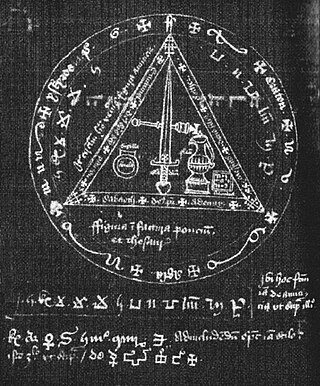
During the Middle Ages, magic took on many forms. Instead of being able to identify one type of magic user, there were many who practiced several types of magic in these times, including monks, priests, physicians, surgeons, midwives, folk healers, and diviners. The practice of magic often consisted of using medicinal herbs for healing purposes. Classical medicine entailed magical elements. They would use charms or potions in hopes of driving out a sickness. People had strongly differing opinions as to what magic was, and because of this, it is important to understand all aspects of magic at this time.

The Ribe skull fragment is a section of human skull bone inscribed with runes and unearthed in 1973 in an archaeological excavation at Ribe, Denmark. It dates to circa 725 CE.

A prominent position is held by rings in early Germanic cultures, appearing both in archaeology throughout areas settled by Germanic peoples, and in textual sources discussing their practices and beliefs. They are notably associated with the related aspects of wealth, being used as forms of currency in the Early Medieval Period, and swearing sacred oaths, often dedicated to, or witnessed by, the gods. The sacrality of rings is reflected in Germanic mythology and ring bestowal held a central role in maintaining functional relationships between rulers and their retinues. The cultural roles of rings continued to varying extents during and after the Christianisation of the Germanic peoples, such as in gift-bestowal and oath-swearing.

The near Fakenham plaque is a lead plaque uncovered in Norfolk in England, dating to between the 8th and 11th centuries CE. It is notable for its Old English runic inscription that has led to the widely accepted interpretation of the item as having been used for healing an affliction either caused by, or conceived of, as a dwarf.
{{citation}}: CS1 maint: location missing publisher (link){{citation}}: CS1 maint: location missing publisher (link)